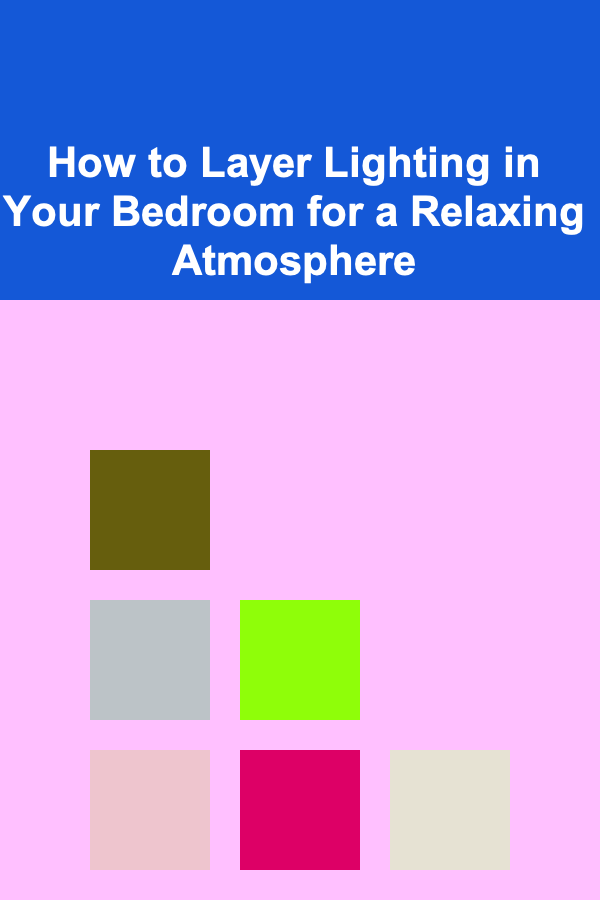
How to Layer Lighting in Your Bedroom for a Relaxing Atmosphere
ebook include PDF & Audio bundle (Micro Guide)
$12.99$5.99
Limited Time Offer! Order within the next:

When it comes to creating a relaxing and restful atmosphere in your bedroom, lighting plays a pivotal role. The right lighting can transform the room into a sanctuary that promotes rest, relaxation, and rejuvenation. Whether you're winding down with a book, preparing for sleep, or simply enjoying the peaceful ambiance, the way you layer lighting in your bedroom can set the tone for the entire space.
In this article, we'll explore how to layer lighting in your bedroom to create the perfect relaxing atmosphere. From ambient lighting to accent lighting and task lighting, we'll discuss the different types of lighting you can use, how to strategically combine them, and how to make the most of your bedroom's lighting design.
The Power of Layered Lighting
Layering lighting refers to the process of using different types of lighting to create a well-balanced and functional illumination scheme. Instead of relying on a single light source, layered lighting allows you to control the intensity, mood, and focus of the lighting based on your needs. This concept can be particularly effective in the bedroom, where you may want different lighting for various activities---whether you're reading, relaxing, or sleeping.
The key to layering lighting in your bedroom is creating a harmonious balance that feels comfortable and soothing. The combination of ambient, task, and accent lighting will ensure that the space is both functional and inviting, making it the perfect haven for rest and relaxation.
Types of Bedroom Lighting
1. Ambient Lighting
Ambient lighting is the primary source of light in any room. It provides overall illumination that fills the space without being too harsh or distracting. In the bedroom, ambient lighting should create a soft and relaxing environment, perfect for unwinding after a long day.
There are several ways to incorporate ambient lighting in the bedroom:
- Ceiling Fixtures: Overhead lighting such as flush-mount lights, chandeliers, or pendant lights can provide ambient lighting in the bedroom. While these fixtures can serve as a central light source, it's important to select a fixture with a dimmer or adjustable settings so that the light can be softened as needed.
- Recessed Lighting: For a more minimalist look, recessed lighting can be installed in the ceiling. This type of lighting provides an even, diffuse light that fills the room without drawing attention to the fixture itself. Recessed lights are particularly useful in smaller bedrooms where ceiling space may be limited.
- Wall-mounted Lighting: Wall-mounted fixtures, such as sconces or wall lamps, can provide a subtle form of ambient lighting. These lights are typically mounted on the wall and can be adjusted to direct light where it's needed most.
- Floor Lamps: Floor lamps are another excellent option for ambient lighting. They can be positioned in the corners of the room to create a warm, inviting glow. Many modern floor lamps come with dimmer switches or multiple light settings to allow for customized lighting.
2. Task Lighting
Task lighting is designed to provide focused illumination for specific activities. In the bedroom, this type of lighting is ideal for reading, working, or performing other tasks that require concentrated light. Task lighting should be bright enough to help you perform the activity without straining your eyes, but soft enough not to disrupt the overall relaxing atmosphere of the room.
There are several effective ways to use task lighting in the bedroom:
- Bedside Table Lamps: Bedside lamps are a popular choice for task lighting. They provide focused illumination for reading in bed and can be easily adjusted to suit your needs. Choose a lamp with a dimmable feature so you can control the brightness based on your activity.
- Wall Sconces: Wall-mounted sconces are another great option for task lighting. These can be positioned next to the bed for easy access while reading or writing. Look for sconces with adjustable arms or swivel features to direct light precisely where you need it.
- Clip-on Lights: If you prefer not to take up space on your bedside table, clip-on lights are a practical solution. These lights can be attached to the headboard or wall, offering flexible task lighting without occupying valuable surface space.
- Desk Lamps: If your bedroom includes a workspace, a desk lamp can provide focused lighting for reading, writing, or other tasks. Look for a lamp with a flexible neck that can be adjusted to direct light exactly where you need it.
3. Accent Lighting
Accent lighting is used to highlight certain features or objects in the room, such as artwork, plants, or architectural elements. This type of lighting can add depth, visual interest, and drama to the space. In the bedroom, accent lighting helps create a more intimate and cozy atmosphere, enhancing the overall ambiance.
Here are some ways to incorporate accent lighting in your bedroom:
- Track Lighting: Track lighting can be installed on the ceiling to highlight specific features, such as artwork, photographs, or a decorative wall. This type of lighting is highly versatile and can be adjusted to target different areas of the room.
- Picture Lights: If you have artwork or framed photos on the walls, consider using picture lights to illuminate them. These small, focused lights draw attention to the artwork while also adding a layer of sophistication to the space.
- Under-bed Lighting: For a subtle and stylish effect, consider installing LED strip lighting under the bed. This soft glow creates an ethereal, ambient light that adds warmth and a touch of luxury to the room.
- Fairy Lights: String lights or fairy lights can be draped over furniture, along the headboard, or around windows to add a magical, relaxing atmosphere. These small lights provide a soft, warm glow that creates a calming environment in the bedroom.
- Candles: Although not strictly an electric lighting option, candles can serve as beautiful accent lighting in the bedroom. The flickering candlelight provides a romantic and tranquil ambiance, perfect for winding down before bed.
How to Layer Lighting in Your Bedroom for the Perfect Relaxing Atmosphere
Now that we've discussed the different types of lighting, let's explore how to layer them effectively in your bedroom to create a harmonious and calming environment.
1. Start with Ambient Lighting
Ambient lighting should be your foundation when layering lighting in your bedroom. It provides the overall illumination that sets the tone for the room. Choose a central fixture, such as a chandelier or flush-mount light, to provide general lighting for the space.
If you have a larger bedroom, consider adding multiple sources of ambient lighting, such as recessed lights or floor lamps, to ensure that every corner of the room is well-lit.
2. Add Task Lighting for Functionality
Next, incorporate task lighting to support specific activities, such as reading or writing. Bedside table lamps are a popular choice, but if you prefer a more streamlined look, wall sconces or clip-on lights may be better suited for your space.
Task lighting should be positioned where you'll need it most. If you're reading in bed, place your task lights close to the head of the bed to avoid straining your eyes. Make sure the lighting is adjustable, so you can control the brightness depending on your activity.
3. Enhance with Accent Lighting
Once the ambient and task lighting is in place, add accent lighting to elevate the room's visual appeal. Track lighting, picture lights, or under-bed lighting can help highlight specific features or create a focal point in the room.
Accent lighting should be subtle and not overpower the room. It's meant to enhance the space and create visual interest without taking away from the overall mood you're trying to establish.
4. Use Dimmers for Flexibility
Dimmers are an essential tool when layering lighting in the bedroom. By installing dimmer switches on your ambient, task, and accent lighting, you can adjust the intensity of the light depending on the time of day or the activity you're engaging in.
For instance, you might want bright task lighting when reading or working, but softer ambient lighting when winding down before bed. Dimmer switches allow you to customize the lighting to suit your needs at any given moment.
5. Consider Color Temperature
The color temperature of your lighting has a significant impact on the mood of the room. For a relaxing atmosphere, opt for warm white lighting (around 2700K to 3000K). This color temperature creates a cozy, inviting glow that's perfect for unwinding.
Avoid using harsh, cool lighting in the bedroom, as it can feel too sterile and energizing. Instead, choose lighting with a warm or neutral tone to create a calm and serene environment.
6. Create Layers of Light at Different Heights
To create a more dynamic and comfortable space, try to position your lighting at different heights. Combine floor lamps, table lamps, wall sconces, and ceiling-mounted fixtures to create varying layers of light throughout the room.
Lighting at different heights creates depth and dimension, helping to create a balanced and visually appealing atmosphere in the bedroom.
7. Integrate Natural Light
Natural light is an essential element of any relaxing space. In the bedroom, natural light helps promote a sense of openness and tranquility. If possible, try to maximize natural light by keeping your windows unobstructed.
Consider using sheer curtains or blinds to allow natural light to filter in while still maintaining privacy. During the daytime, let the sunlight stream in to brighten the room, and in the evening, rely on your layered artificial lighting to create the perfect ambiance.
Conclusion
Layering lighting in your bedroom is a powerful way to create a relaxing and restful atmosphere that promotes relaxation and well-being. By thoughtfully combining ambient, task, and accent lighting, you can control the mood, functionality, and aesthetic of the space, making it the perfect retreat for unwinding at the end of the day.
Remember to start with a solid foundation of ambient lighting, add task lighting for specific activities, and incorporate accent lighting to highlight features and enhance the ambiance. With the right lighting, your bedroom can become a serene sanctuary that fosters relaxation and rest, night after night.
Reading More From Our Other Websites
- [Home Pet Care 101] How to Get a Cat to Drink More Water
- [Personal Care Tips 101] How to Choose the Best Toothpaste for Whitening Sensitive Teeth
- [Personal Financial Planning 101] How to Budget for Irregular Income as a Freelancer
- [Home Storage Solution 101] How to Keep Your Furry Friend's Gear Organized: Clever Storage for Pet Supplies That Blends with Your Decor
- [Personal Financial Planning 101] How to Understand the Difference Between Saving and Investing
- [Home Holiday Decoration 101] How to Incorporate Holiday Scent Ideas in Your Home
- [Horseback Riding Tip 101] Best Winter Riding Gear to Keep Both Rider and Horse Warm in Sub‑Zero Conditions
- [Home Storage Solution 101] How to Tidy Up Your Home With the Right Storage Baskets
- [Personal Investment 101] Turning Your Deep Learning Projects into Money-Making Opportunities
- [Home Rental Property 101] How to Inspect Houses for Rent with a Fireplace for Potential Safety Hazards Before Signing a Lease

How to Build a Budget for Hosting Family Gatherings at Home
Read More
How To Choose the Best Birding App for Your Smartphone
Read More
How to Incorporate Seasonal Colors into Your Closet
Read More
How to Use the KonMari Method for Effective Tidying
Read More
Observing Open Clusters: A Deep Dive
Read More
10 Tips for Baking the Perfect Sourdough Bread
Read MoreOther Products

How to Build a Budget for Hosting Family Gatherings at Home
Read More
How To Choose the Best Birding App for Your Smartphone
Read More
How to Incorporate Seasonal Colors into Your Closet
Read More
How to Use the KonMari Method for Effective Tidying
Read More
Observing Open Clusters: A Deep Dive
Read More